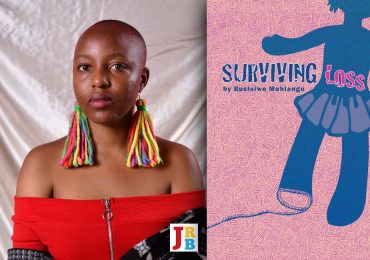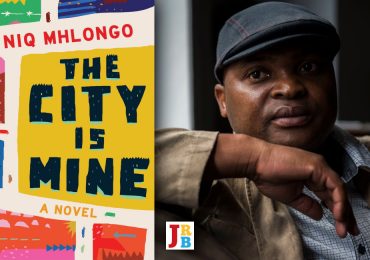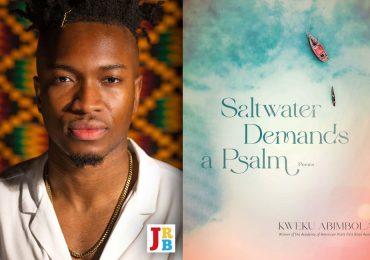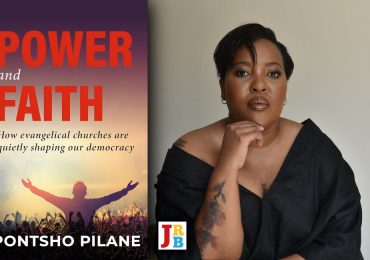As part of our January Conversation Issue, guest City Editor Lidudumalingani chats to Outlwile Tsipane about the literatures of Johannesburg.
The city of Johannesburg, to those who did not grow up in it—even more to those who grew up far away from it, experiencing it only through literature—has always been distant, materially and in feeling. Its geography is almost alien. The buildings that seem to be growing taller and taller towards the sky, as if the sun and rain are nurturing them, make no sense to a boy growing up in the villages. Through literature and film one could get a sense of it, but even then the sense was floating, not grounded in reality. For me, it was leaving the villages and studying in East London that gave me a glimpse of what taller-than-flat architecture looked like, and what negotiating space on public roads was like. In essence, Johannesburg will always be the city that was first conjured up in my mind by literature, long before I saw it. So, for this Conversation Issue, Outlwile and I discuss the literature of Johannesburg. It is a conversation that could be had over many months, each day uncovering a text that opens a new layer of the city. We attempt to do this in a few paragraphs.
Lidudumalingani: The first day I arrived in Johannesburg wasn’t my first time. Though I had never set foot in the city before, it felt as if I had been there many times, as many people. As night gave way to morning, the Shosholoza train did not hint that we were arriving in Johannesburg—as it did in the small towns of the Free State, Kroonstad, Heilbron, Sasolburg, which flood the train with their toxic chemical smell from the mines. The train simply arrived in Jozi without warning, as if to say, nothing here is as you know it, nothing here is as it was yesterday, and so what is the point? I remember that when the announcement was made that we had arrived, morning turned into night again. Park Station swallowed the train whole, before the train itself spat out throngs of exhausted and eager people into an entirely shifting world. It would take another half an hour for us to disembark and come above ground, to see the day, to see the light. I emerged to a world that was unfamiliar but felt in every way familiar. I was faced with strange tall buildings and structures, chaotic streets and dangerous corners, but I imagined that up there in one of those buildings were gathered all the characters from Kgebetli Moele’s Room 207. As the car moved out of the inner city into Auckland Park, past Wits University, I became Dingz, from Niq Mhlongo’s Dog Eat Dog, looking wide-eyed at the city. Much like in the film They Live, by John Carpenter, the literature I was reading became the lens I experienced the city through. This is a long-winded way to ask, Outlwile, what was your first time arriving in Johannesburg like, and what literature, if any, did you arrive to?
Outlwile Tsipane: There’s this memory I have of the first real time I travelled to Johannesburg. I am certain it was winter, from the beanies and scarfs that we wore. It was late at night when we left, and we received assurance that by daylight the sprawls of Jozi city would be before us. I remember that we made a stop at some large mountainous hills, and it later emerged as I made the back and forth trip at a much older age, between my hometown of Huhudi and Jozi, that this was the town of Klerksdorp. Those mountains that I’d seen were mine dumps. It is on the back of these memories, and others, that I think of Niq Mhlongo’s short story, in his collection, Soweto, Under The Apricot Tree, which talks about Jozi’s mine dumps. It reflects, if you think of it, on the beginnings of Johannesburg, what made it come to be. The mining hive of it all. And in other ways, how the mines have been left dry and unsafe, a place where the so-called zama-zamas, in their dangerous pursuit of a living, scavenge for the last remnants of gold. Fred Khumalo’s The Longest March also delves into the city’s formative years, its mining history and its underbelly and subcultures, this association with crime and criminal havens that the city has always carried.
When I think of the people I first met in Joburg I think of Fana, from Niq’s other collection of short stories, Affluenza. Jozi churns out people like Fana by the bucket-load, the type that leads a pretentious life, making claims of having money, hustling, because in Jozi you must always be seen as making it or having made it.
Which brings me to my question to you. Often, the first notable reference made about the city is its crime or the perils that we should be cautioned against. The fear that is driven into us when we think of people like Xhawulengweni, in the aforementioned The Longest March, and the more modern prototype, if you will, of one Mabegzo in Redi Tlhabi’s Endings and Beginnings.
Lidudumalingani: You are steering the conversation in an interesting direction. The question you are posing, without doing so, by referencing The Longest March, involves ways of belonging. Not so much the people of the city but the city itself. Ivan Vladislavić consistently chronicles Johannesburg in his work, but his Johannesburg is very different to Miriam Tlali’s in Between Two Worlds, or Can Themba’s in The Will to Die. Ivan chronicles a very particular Johannesburg, often a nostalgic one, even when writing about a post-apartheid city. I want us, I suppose, to think of all of these different texts and how they all capture, or semi-capture, Johannesburg. And if they tell us anything at all about the spatial and social economy of the architecture of the city.
Tsipane: You’ve led me to think about the famous ‘poor Hollywood imitation’ accusation that Es’kia Mphahlele levelled against the writing of his colleague Can Themba, a charge put forward too in another way by other critics, who deemed his work to be ‘flippant’. But Themba’s manner can be seen, perhaps, as a coping mechanism of sorts, a way to navigate those treacherous times. Of course the two, Vladislavić and Themba, move and moved in different worlds, a vital point, and that is why their gaze would and should differ. The common aspect to it is that, in all of this, they are both paying homage to this city and its intrigues.
The segregated spatial planning of the city is still in evidence today, Blacks flung to the bad side of town and the White folk given what is prime. The proximity or access to the city is difficult, burdensome for Black people. This far-away-from-the-city-living is what Themba loathed; he always wanted to be close to it, even though the laws often prohibited him from being so. Dr Siphiwo Mahala, a Can Themba scholar, related a story to me a couple of weeks ago, in December, which illustrates the excessive nonchalance Themba was often accused of. He had taken his white girlfriend, a woman of British descent, to Sophiatown after going out to a party. The police got wind of this and they went to arrest Themba, missing him by a whisker. Meanwhile, Themba had woken his girlfriend up in the middle of the night and insisted they drive back to the party. When quizzed later on his good fortune in evading an arrest, the irrepressible Themba told of how there was no alcohol at his place and he’d remembered that he had left a bottle of whisky, which was still full to its shoulders, at the party. We can see the lighter side of this tale, but again, isn’t it an example of how Can Themba just wanted to exercise his rights, even if it meant pushing the boundaries? And doesn’t Vladislavić, too, push the boundaries of convention in the setup of his books? We can find similar imposed limitations in the characters if Vladislavić’s book The Exploded View. It’s admirable, too, how Vladislavić captures, as you put it, the architecture of the city’s makeup, how he makes us imagine the unimagined. Think of Hani View, the RDP project in The Exploded View, which strikes a similar note to Themba’s Sophiatown, back then. The more things change …
Vladislavić has infused David Goldblatt’s photography into his writings in a haunting and evocative way. You yourself are a trained photographer and I know you often capture Johannesburg and its landscapes. Is there a writer, past or present, who has written about this city who you’ve thought; ‘Ah, this particular scene could be a great photograph’—?
Lidudumalingani: My brain renders any text I read into photographs. This is why I gravitate towards Ivan Vladislavić, even though at times he can feel distant. All of Ivan’s work has a strong visual aesthetic.
Going back to Can Themba, though, what you are saying about his work brings to mind how Miriam Tlali’s out-of-print novel Between Two Worlds was originally titled Muriel at Metropolitan. It is a book I have read more about than reading the actual book itself; but the title intrigues me, what it captures, what it says of Johannesburg and her lived experience. The very thing you are saying here.
Tsipane: Our experiences are the same. I’ve only read about it. It would be great if it were to be published again in South Africa. I’ve read that Between Two Worlds was the title Tladi preferred, but that Ravan Press warned that the title would raise the eyebrows of the apartheid government. These two worlds still do exist, to a varying degree. Wake up in Soweto, go to work in Sandton, and back to Soweto in the evening. Just as it was for Can Themba. Sophiatown at night, Johannesburg city in the day. What I mean by ‘to a varying degree’ is that Black folk are now able to live in places that they were barred from during apartheid. But it would remiss of me not to mention that some of the core socioeconomic problems remain.
Going back to the Drum-era cohort, there’s a thought I wanted to put forward. My favourite of them all is Nat Nakasa. I think my adoration is brought about by the nerd in him. The first time he walked into the newsroom, he had a tennis racket in his hand. In those days, imagine! I read that in The World of Nat Nakasa. Moving between two worlds was a bane for Nakasa. He abhorred it. I always wonder, when I travel around the city, how he would view the Johannesburg of today. I think he would have enjoyed it. He received his fair share of criticism too, for his rainbowism ways.
Lidudumalingani: Rainbowism is the perfect segue into my next thought. Do you think it’s possible to write a friendlier and prettier Johannesburg?
Tsipane: It can’t be all gloom and doom, man. There is beauty in all of this ugliness, the unfairness of the past, which is still in the present. I don’t think it should be a pursuit, to write it friendlier or prettier. I reckon it could derail a writer, to be beholden by such an intent. Joburg should be depicted in the way it is. The beauty or ugliness, the pleasant or unpleasant, will emerge. Which reminds me of Kgebetli Moele’s Room 207, which you mentioned earlier. By the time I read it, I had been told the story before. My boss of three years and his partners at the company I worked for were the characters in that book. All of their escapades were there. Room 207 conjured a feeling of beauty within me; I laughed all over again at their tales, although they were being told, this time, by another person. If there should be a pursuit, it should perhaps be this kind of representation.
I found myself in that book, too. There was this time I had invested in a property in Yeoville. I dealt with tenants who were subletting the property and doing all of these other things tenants do. What bears emphasis for me is that Johannesburg’s story has not been told enough. There is plenty to be written, history yet to be depicted, that has relevance to the current moment. That is what is missing for me. The text put together by Bongani Madondo in I’m Not Your Weekend Special is very much a Johannesburg story for me. We need more books in that mould and beyond that genre, that trace those aspects of the city; its cultures, its subcultures, that capture the ambience, what was happening, especially the period leading to ’94.
Lidudumalingani: My pursuit, I guess, is interrogating what beauty is in a city like Johannesburg, and why that beauty is scarce in literature. I agree that this beauty is not a thing that is removed from what is true of the city; it exists in the ugly truths of the city. It is found in the ugliness of the city. But what is lacking are texts that begin with the premise that Johannesburg is a beautiful city, even if it is also ugly. Instead of the other way round. One can write beautifully and trace the orange hues of the sun as it sprinkles magical dust all over the city, yet recognise the deafening terrified scream of a woman being mugged downtown on a street corner. The question is really about what other alteration of Johannesburg awaits the reader. What do you think?
Tsipane: I took a peek into my library, wanting to see if there was literature specific to our city. Instead I came across titles like The Carnivorous City by Toni Kan and Welcome to Lagos by Chibundu Onuzo, both books that deal capably, although very differently, with the city—but it is the Nigerian city of Lagos. To answer this longing of yours, which is mine too, I was overcome by a sense of poignancy after finishing Masande Ntshanga’s Triangulum last year. The book unfolds with a futuristic portrayal of the city, and in the deft way Ntshanga speculates you may find this Johannesburg we envisage. What I’ve mulled over in my daydreams is a way to carve myself a figurine, a cross between Madondo and Ntshanga, and then bring it to writing life. I’m certain the former, a mainstay who has strode through different decades, blended with this wondrous voice that is emerging in Ntshanga, would produce this new Johannesburg you are asking for.
Lidudumalingani: In every way, Johannesburg is a city in motion, in stretches, unfurls, unfolds. I want to read more literature that does this. That does more. I also want to read literature that imagines the city a thousand years from now. That imagines the city streets filled with robots rather than people. Literature that imagines the architecture of the city as something that bows to the sun as it rises and sets, instead of concrete buildings that block out the light. And I think it is possible. There is a crop of writers who are writing otherworldly literature, and I cannot wait to read Johannesburg rendered in another dimension all together, a futuristic Johannesburg.
Tsipane: There’s a cohort that held the fort before and made the post-apartheid transition, right? Some had been in exile and those that remained were limited in what they could write, given the bans imposed by the apartheid government. There was also of course a lack of books by Black writers being published. I imagine the pressures on a writer like K Sello Duiker in 2000. And the heaps of praise led to more pressure. There’s almost no gap between Thirteen Cents and The Quiet Violence of Dreams; the former was not allowed to have a life of its own before the latter was released. There was also Phaswane Mpe. But that was not enough. It must have been a serious relief when a writer like Niq Mhlongo published and gave us Dingz. Duiker was making waves and had been covered all over. When the New York Times came calling, asking him what was happening in the South African literature scene, he recommended Mhlongo. What followed has been very encouraging. But I think there needs to be more written on Johannesburg in the new tradition of Mpe and Moele. That is where the focus should be. Although there may be texts geared towards representing Johannesburg in this way that I have missed. We must keep reading.
- Lidudumalingani is a writer, filmmaker and photographer, and winner of the 2016 Caine Prize. Follow him on Instagram and Twitter.
- Outlwile Tsipane is a literature all-rounder, organising events, facilitating at book festivals and launches, and in management. He has an essay featured in the new book, Black Tax, and he co-writes/runs a football blog called Show Me Your Number. Follow him on Twitter.





